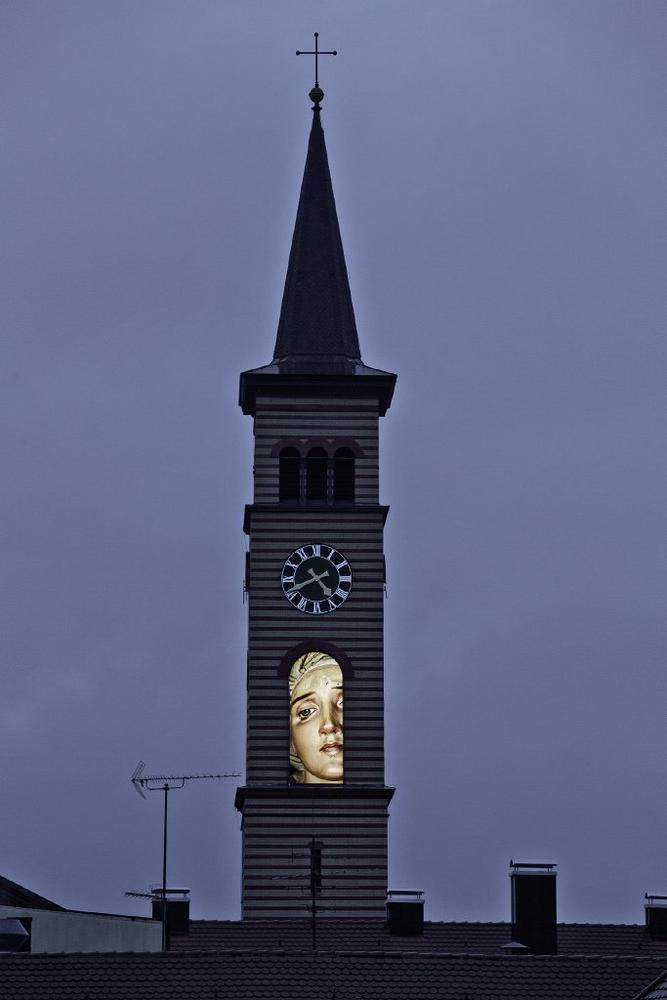This was created in 2014, as a site-specific installation of large-format light boxes for the city of Friedberg near Augsburg. Now, finally, the artist has been able to bring herself to produce a more manageable version of some of these images ¬ after all, they were originally up to six meters high, which is an appropriate format for mounting in the belfry of a church tower, but is a poor fit for most people’s living rooms.
This, of course, changes their character, as does their transformation from light boxes into "normal" framed photographs, but it has the invaluable advantage that people outside Friedberg will be able to view them and, above all, study them up close.
What we see here are not portraits in the conventional sense, but faces of sculptural, carved and painted figures of saints from the Middle Ages and Baroque.
For this purpose, the artist had roamed the churches and museums of Friedberg at the time and recorded what particularly caught her attention: Madonnas without children, Jesus boys without mothers, thorn-crowned men of pain, angels and saints.
Brockmann’s art consists of photographing the faces – and only them – in such a way that we feel directly touched, even gazed upon by the figures. And to bring them as close to us as possible through their cropping.
The extreme close-up view also draws our attention to the partially scratched and splintered surfaces of the wood and to the faded, flaking or completely destroyed parts of the colored version. Strangely enough, one feels this less as a restorative art-historical inventory than as real injuries of the depicted figures, so present, contemporary and human they seem to us. Through their complete decontextualization, these sacred images are profaned, but at the same time they become visible in an immediacy as a counterpart that makes them (only or again) contemporaries of us.
In this respect, this reunion is highly gratifying, as it shows that these expressive faces lose none of their enormous fascination even in a smaller format.
But another déjà vu creeps into the consciousness of the art-minded viewer: haven’t there just been exhibitions on view that pursued a very similar theme? That’s right, paintings by Karin Kneffel, which were first presented in Rome, then in Düsseldorf (and will soon be on view in Kleve).
There, the renowned painter showed large-format canvases on which she painted Madonna figures with child, all of them medieval, colorfully painted wooden sculptures, and presented them in extreme detail as a pair of pictures, each with a mother and a child image.
That Kneffel’s double-headed strategy would have worked cannot necessarily be said; in the conversion from painted wood to painted canvas, from 3D to 2D, and the accompanying monumentalization, the faces became demonstratively expressionless-and above all, well, somewhat flat.
Both the motivic close proximity to Brockmann’s paintings and essential transformation steps, such as the restriction to the faces, the cropping, and the change in scale, one would like to think are coincidental. After all, artists have always made use of the fund of art history, sometimes more, sometimes less obviously.
But when painters help themselves to their colleagues, that is something else. It doesn’t help when Kneffel’s gallery proclaims that her current paintings are "unprecedented". The opposite is true.
There is a catalog of Brockmann’s "Glück," which Ms. Kneffel is also demonstrably familiar with.
Fortunately, we do not have to content ourselves here with reproduc.ons or stale repe..ons; we can deal quite directly with the much more successful transposi.ons of medieval image carving into contemporary art:
In Elisabeth Brockmann’s work, there are plenty of exci.ng pictorial details to discover: a chubby-cheeked child’s face, like a piece of rather crude, naive pain.ng (not dusty, but closer to a doll’s head than a Modersohn-Becker). The already somewhat finely drawn, clever, almost haughty features of a narrow woman’s face with very red painted lips. The strangely ageless head of curls with the roundish facial forms and a clear tendency to a double chin, whose eyes look so differently that it is impossible to say whether it looks astonished, pityingly, sadly or lovingly?
Ul.mately, it’s the same here, with the ar.s.c varia.on of a theme, as in music with the art of covering: there are bad, superfluous and boring cover versions, which make you long for the original aSer a very short .me. And there are the good ones, which gain something completely new from their role model or add something essen.al. Then the imita.on turns into crea.ve ac.on and in the best case: into great happiness.
Galerie Wittenbrink
Türkenstraße 16
80333 München
Telefon: +49 (89) 26055-80
Telefax: +49 (89) 26058-68
http://www.galeriewittenbrink.de/
Telefon: +49 (211) 93895777
Fax: +49 (179) 7063852
E-Mail: drtuchel@textpublik.de
![]()

